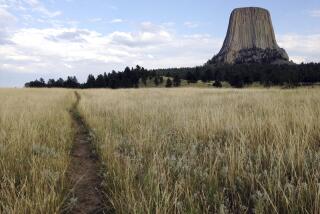Breath of Fresh Air Is Rare in Great Smoky Mountains
GREAT SMOKY MOUNTAINS NATIONAL PARK, Tenn. -- A slow procession of cars arcs around Cades Cove, a grassy valley so rich in wildlife that the deer feed right next to the one-lane road. Not far from where a group of Illinois tourists has halted traffic to point their video cameras at four wild hogs, a research scientist aims at a different target: the tailpipes of this ceaseless stream of vehicles.
Using computers and infrared light, the roadside researchers are measuring the exhaust from vehicles traveling throughout the park. A separate experiment is taking place high in a section of the park called Newfound Gap, where investigators are checking the breathing of hikers along a four-mile portion of the Appalachian Trail.
The two testing programs, both begun in recent weeks, are part of a larger effort to figure out just how big a mess has been made of the air surrounding Great Smoky Mountains National Park, half a million acres of abundant old forests and rivers straddling Tennessee and North Carolina.
The news is already known to be bad. The park, whose 9.5 million visitors make it the most-visited national park in the United States, also suffers the worst air pollution--often worse than cities such as nearby Knoxville, Tenn., or Atlanta, 150 miles to the south. The mountains corral contaminants drifting from dozens of coal-burning power plants and factories in the region, and from fast-spreading cities and growing fleets of cars.
A 10-year study of air pollution in the southern Appalachians concluded Thursday that most of the area’s haze is produced locally, contradicting a long-held view that it comes from industrial states like Ohio and Pennsylvania. The study of pollution in eight states pinned blame mainly on power plants.
Still more pollution comes from the millions of vehicles circulating in the park.
The most obvious result is a whitish haze that on many days obscures the steep hillsides of pine, poplar and oak. It is quite different from the naturally occurring wisps of moist mountain air that inspired the early Cherokees to name the area the “land of blue smoke.”
At higher elevations, the haze is “not much different than the L.A. Basin,” said park Supt. Mike Tollefson. “It’s not as brown, but on a bad summer day it’s truly not much different from L.A. in air quality and health effects.”
Visibility from lookouts such as the 6,600-foot Clingmans Dome has dropped during the summer months by 80% since 1948, according to studies. Spots that should afford 100-mile views under ideal conditions now yield just 25; that range drops to 15 miles in summer.
“We’ve been coming up here for 50 years and it’s a marked decrease in visibility,” said Glenn Lynch, from Jefferson City, Tenn., who was visiting the park with his wife.
Deteriorating vistas are not unique to the Smokies. Smog and soot have smudged views at national parks all over, from Big Bend in West Texas to Sequoia/Kings Canyon in California. The parks’ dirty air has been a central theme in the debate over proposals to place stricter federal standards on old power plants and other facilities burning fossil fuels.
Nowhere has the problem been more evident than at Great Smoky Mountains National Park. The park operates seven air monitors, measuring ozone, acidity and other factors. The readings often indicate unhealthy air.
“People don’t expect that. They think they’re going to a national park area and the air should be pristine and clean. It’s not,” said Janice Nolen, director of national policy at the American Lung Assn., which is sponsoring the two-week tailpipe study, described as the first of its kind in a national park.
The project, which began Tuesday, was timed to coincide with the busy Labor Day weekend, when traffic is heavy. The goal is to learn how much of the park’s pollution is coughed up from the cars of its visitors. A report is due in October.
Park planners are considering ways to cut traffic in congested sections such as Cades Cove. One suggestion is to have a tram or bus system replace cars on the 11-mile, single-lane loop.
Two million visitors a year motor around the tranquil meadows, which are dotted with cabins dating to the early 1800s. Motorists stop constantly to gawk at deer or black bears, creating tie-ups that can turn the scenic valley tour into a four-hour ordeal. Other national parks, including Yosemite and Grand Canyon, have restricted access by private vehicle.
The hiker study, which involves researchers from three universities, seeks to gauge the effect of airborne pollutants on park visitors who are exercising. Hikers setting out from Newfound Gap, at 5,000 feet, are asked to fill out questionnaires and to blow into a device to gauge the size of a breath and how forcefully it is expelled. The volunteers are also asked to measure their pulse while hiking. The park’s levels of sulfur and nitrogen--the makings of acid rain--and of ozone are among the highest in the eastern United States. Ridge-top ozone readings are twice as high as those found in Knoxville and Atlanta. Park visitors encounter roadside displays describing the pollution. A computerized kiosk inside the visitor center carries a live video feed from a camera at Look Rock and flashes real-time ozone levels, as measured by remote monitors.
In summer, park officials regularly issue health warnings on days when ozone levels exceed federal clean-air standards. The park has registered 36 unhealthy days this year--a pace ahead of that in 1999, when there were 52, the most on record.
The park’s tall reach means that its peaks soak in acid-rich clouds and often experience high ozone levels even overnight, when the chemical usually dissipates in low-lying areas.
“It may be more unhealthy to hike the [Appalachian Trail] at 8 in the morning than to be in Atlanta” on a bad-air day, said Jim Renfro, the park’s air-quality specialist.
No species have died off, but park officials said there has been harm. Park studies have shown that high ozone levels threaten at least 30--and possibly up to 90--species of plants and trees, including black cherry, tulip poplar, sassafras and tall milkweed.
Sulfur and nitrogen overload soils, interfering with the ability of plants and trees to gain nourishment and raising the acidity of streams where trout and other creatures dwell.
Renfro said the park’s air quality mostly has worsened over the last 15 years, despite improvements by nearby utilities in reducing contaminants during power generation. Pollution wafts in from as far as the Midwest, while contamination from sources such as automobiles has grown, he said.
Most agree it’s unlikely the Smokies’ haze will be cured by targeting tourists’ cars. Some visitors said limiting cars in Cades Cove might give them less chance to see the animals that drew them. Others said a tram seemed a good idea.
For John Leary, a store manager from Springfield, Ohio, who was taking pictures of a 180-year-old cabin, the once-clear vistas appeared increasingly a thing of the past too. Leary recalled his family’s pictures of the Smokies, taken during vacations in the 1960s. “They seem to be a lot more crisp and clear,” he said.
More to Read
Sign up for Essential California
The most important California stories and recommendations in your inbox every morning.
You may occasionally receive promotional content from the Los Angeles Times.










